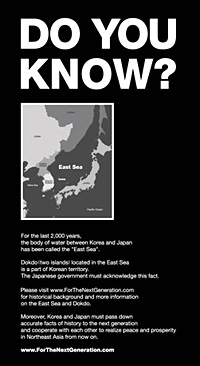A popular Korean singer has taken out a full-page advertisement in the New York Times in an effort to educate the world that Dokdo is Korea's territory and not Japan's territory.
To read an article about it by The Korea Times see below or go to:
http://www.koreatimes.co.kr/www/news/nation/2008/07/113_27378.html
And the ad actually got attention from the American press and AP did a story about it. ![]()
Read the AP story about it by viewing below or going to:
http://news.aol.com/story/_a/ny-times-full-page-ad-claims-disputed/n20080710024009990016?ecid=RSS0001
To see an English-language website that was created to promote to the world Korea's claims, and that shows past and future ads regarding Korea's claims in major English-language newspapers, go to: www.forthenextgeneration.com ![]()
| Quote: |
| The Korea Times Popular Singer Finances Dokdo Promotion Ad in NYT By Park Si-soo Staff Reporter A popular Korean singer financed a full-page advertisement on Dokdo ㅡ two tiny islets in the Ease Sea ㅡ in The New York Times to reaffirm the islets are a part of Korean territory. The vocalist Kim Jang-hoon, 41, teamed up with a freelance Korean public relations expert Seo Kyoung-duk to publish the ad in the major American newspaper. The advertisement, published on July 9 with the headline of ``Do You Know?,'' stated ``For the last 2,000 years, the body of water between Korean and Japan has been called the `East Sea.' Dokdo (two islands) located in the East Sea is a part of Korean territory. The Japanese government must acknowledge this fact.'' It also asked for cooperation between the two governments to pass down accurate facts of history to the next generation and realize peace and prosperity in Northeast Asia. The publication came amid escalating tension between the two countries fueled by the Japanese government's recent attempt to add Dokdo to a part of Japanese territory in a new reference book for middle school students. In addition, the name ``East Sea'' has also been one of the most controversial issues between the two states. The Korean government has named the body of water the ``East Sea,'' while the Japanese government has called it the ``Sea of Japan.'' ``The advertisement is an act of civilian diplomacy,'' Yonhap News quoted Kim as saying. ``Civilians' unified move against U.S. beef imports made Seoul and Washington sit at a renegotiation table. I think our collective move, embodied in the ad campaign, will be a steppingstone to globally inform people that Dokdo belongs to Korea.'' Seo plans to publish similar ads in other influential newspapers next year to commemorate Korean Independence Day, which falls on Aug. 15. ``With support from Mr. Kim, Internet users and overseas Koreans, I will constantly do the ad campaign,'' Seo said. For more information about Dokdo, please visit www.forthenextgeneration.com pss@koreatimes.co.kr Source: The Korea Times; July 10th, 2008; http://www.koreatimes.co.kr/www/news/nation/2008/07/113_27378.html |
| Quote: |
|
The AP
http://forums.eslcafe.com/korea/viewtopic.php?t=128505&postdays=0&postorder=asc&start=0 |
'Life > e—dialect—dialog' 카테고리의 다른 글
| 7 Things You Didn't Know about Tibet - Donald S. Lopez Jr. (0) | 2008.07.24 |
|---|---|
| 신의 길 인간의 길 (0) | 2008.07.20 |
| [스크랩] 30일 서울광장 시국미사 참례기.. (0) | 2008.07.01 |
| 나는 대한민국의 블로거다 (I am a Korean blogger) (0) | 2008.06.30 |
| Barack Obama (0) | 2008.06.04 |


